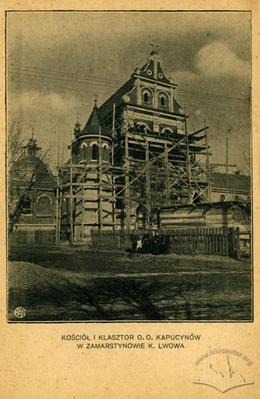Vul. Zamarstynivska, 134 – St. Iosafat church (former church of st. Francis of Assisi) ID: 2045
The former church of St. Francis of Assisi was built in 1927-1930 under a project designed by architect Jan Sas-Zubrzycki in the Historicist style with some elements of Neo-Gothic, northern Mannerist, and early Baroque styles. The building is an architectural monument of local significance (protection number 2679). Since the late 1980s–early 1990s the church has been used by the Redemptorist monks (the Order of the Most Holy Redeemer) of the Ukrainian Greek Catholic Church. In 1990 it was consecrated in the name of St. Josaphat.
Story
The former church of St. Francis of Assisi was built as a church at the Capuchins' monastery. The first wooden chapel in its place was built in 1904 by architect Zygmunt Krykiewicz. A fundraising campaign for the construction of a new shrine started in the 1910s and continued after the end of the First World War (a debate about the necessity of building a new church was for the first time held in 1909).
In 1921-1925 a project was designed by architect Jan Sas-Zubrzycki. On 12 September 1925 his project was approved by the General Administration of the Capuchin Order. The construction of the monastery began in 1927. The church was completed in 1930 (consecrated on 5 October).
In 1946 the Capuchins left Lviv for Poland, taking away some items of the interior decoration. After their departure, a film library was arranged in the former church. At the turn of the 1990s the church building was restituted to the faithful, in the person of the Redemptorist monks (the Order of the Most Holy Redeemer). On 14 October 1990 it was consecrated as the church of St. Josaphat.
In the 1990s a considerable amount of work was carried out in the church for the arrangement of the interior. An iconostasis, altars, and ornamental paintings were made. Above the triumphal arch, a bright multi-figure composition "The Protection of the Mother of God" was arranged, Christ and angels were depicted in the sanctuary and the Evangelists on the sails (the murals were made by professor Liubomyr Medvid). Repair and restoration works were continued after 2000 as well.
The relics of Blessed Martyr Mykola Charnetskyi (1884-1959) are kept in the church; they were moved here from the Lychakivskyi cemetery in 2002 after his beatification by Pope John Paul II in 2001.
The church of St. Josaphat (the former church of St. Francis of Assisi) was entered in the protection register as a monument of architecture of local significance under the number 2679 (order of the representative of the President of Ukraine in the Lviv region number 374 dated 15 April 1994). It belongs to the Lviv Province of the Order of the Most Holy Redeemer, the Monastery of St. Josaphat.
Architecture
The church of St. Josaphat is located in the northern part of the city, on the territory of the former suburban village of Zamarstyniv. The church was designed as a single complex with the other monastery buildings. Its silhouette is actively perceived from the valley of the Poltva river and from Chornovola boulevard.
The church is a monumental three-nave building of the basilica type, with three apses, a narthex and a bell tower in the northwest corner. Its lateral naves and sanctuary are lower than the central nave. The domed former chapel of St. Anthony is adjacent to the north nave. The naves are covered with cross vaults having ribs, the sanctuary is covered with a semicircular vault.
The façades have open brickwork and stone decorative elements, and arched windows. The main three-tier façade is accentuated by an odd-shaped pediment, designed in the Mannerist-style tradition. The wide main entrance portal is decorated with a gable with a sculpture of St. Francis of Assisi. The exterior composition is enriched by a faceted side tower with a helm top.
The dominant of the church’s modern interior is an iconostasis made in the 1990s in Ukrainian Baroque style. The murals were made at the same time.
In the church shapes, the author of the project used some features of the regional architecture of the 16th-17th centuries, affected by reminiscences of the Gothic, northern Mannerist and early Baroque styles.
Sources
- Marecki J., Dzieje zakonu kapucynów w okresie II Rzeczypospolitej (Kraków, 2000).
- Marecki J., "Konwent Kapucynów we Lwowie-Zamarstynowie" (1903-1946), Folia Historica Cracoviensia, t. 3, 1996, 171-215.
- Brzezina K. "Kościόł p. w. Św. Franciszka z Asyżu i klasztor oo. Kapucynόw na Zamarstynowie", Kościośły i klasztory Lwowa z wiekόw XIX i XX, red. M. Podlodowska-Reklewska (Kraków: Antykwa, 2004), 225-245 [Materiały do dziejów sztuki sakralnej na ziemiach wschodnich dawnej Rzeczypospolitej: Część I. Kościośły i klasztory rzymskokatolickie dawnego Wojewόdstwa Ruskiego, tom 12].









